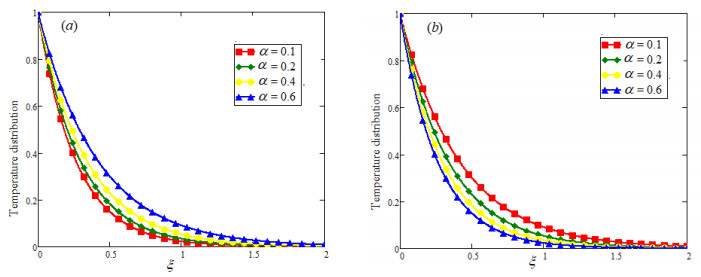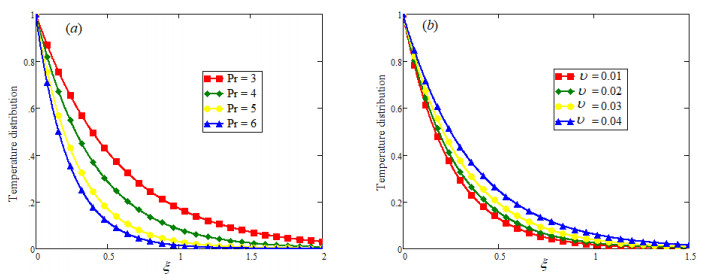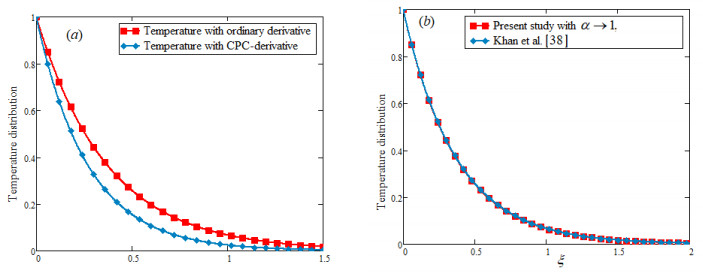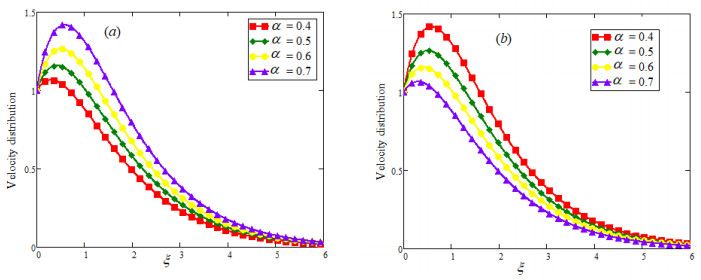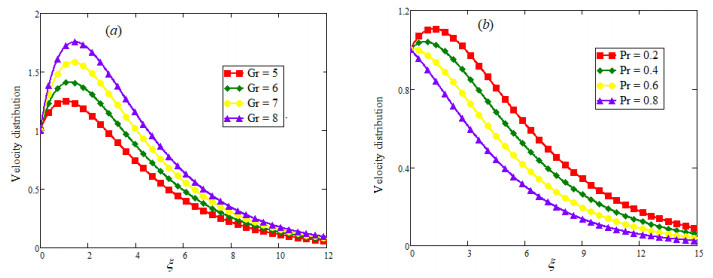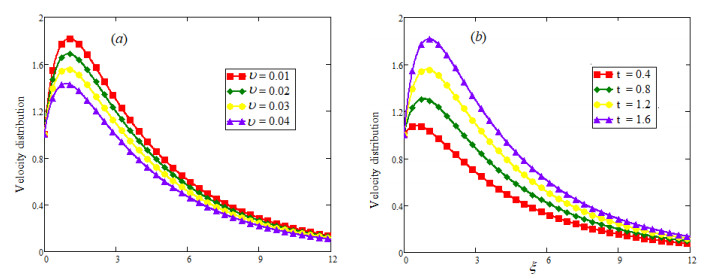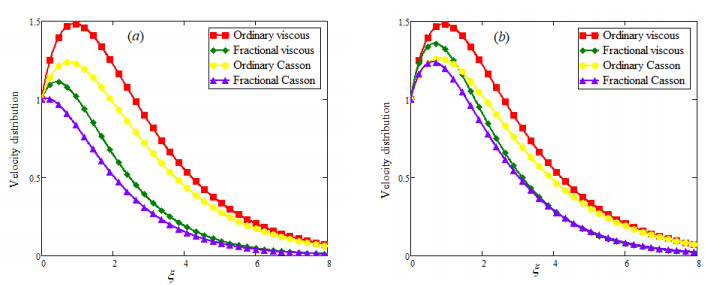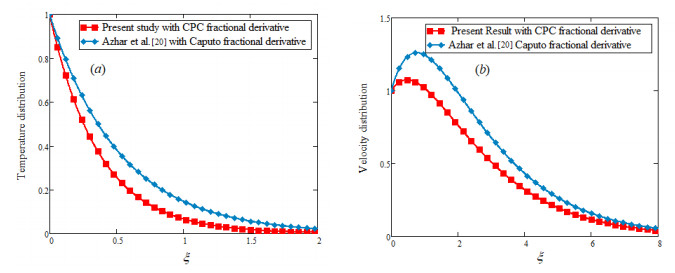Nomenclature
u−Velocity [ms−1]
U0−Constant velocity
s−Non-dimensional velocity [ms−1]
t−Time [s]
τ−Non-dimensional time
y−Special variable [m]
ξ−Non-dimensional special variable
ρnf−Density of nanofluid, [kgm−3]
μnf−Dynamic viscosity of nanofluid [kgm−1s−1]
T−Temperature of Nanofluid, [K]
kf−Thermal conductivity of base fluid
ks−Thermal conductivity of solid particle
knf−Thermal conductivity of the nanofluid, [Wm−2K−1]
ρf−Density base fluid, [kgm−3]
ρs−Density solid nanoparticle, [kgm−3]
υ−Concentration of clay nanoparticle, [kgm−3]
g−Acceleration due to gravity, [ms−2]
γ−Casson fluid parameter
βc−non-dimensional Casson parameter
Gr−Grashof number for heat transfer
β− Volumetric thermal expansion of [K−1]
Pr−Prandtl number
ϕ−Non-dimensionless temperature
T∞−Temperature at infinity, [K]
TW−Temperature at plate, [K]
α−fractional parameter
q−Laplace variable
1.
Introduction
Clay nanoparticles have an important rule for drilling of oil and gases because of its significant thermal conductivity. The addition of clay nanoparticles in base fluid, boosted the thermal conductivity and viscosity of nanofluid that make it capable to resist the higher temperatures. The nanofluids with clay nanoparticles fulfil the challenges to improve the thermal conductivity and improved thermal conductivity boosted the thermal execution in respective devices. Now a days this nanofluids become a potent research area of nanotechnology [1,2,3] and attract the researchers of physical sciences. An interesting work on free convection flow of nanofluid has presented by Asma et al. [4] and explained the effect of volume fraction of nanoparticles over the nanofluid flow with fractional derivative.Hussanan et al. [5] investigated the free convection flow of sodium Carboxymethyl Cellulose based nanofluid with Tiatania nanoparticles, with non-homogeneous thermal and mechanical conditions. Bhattad et al. [6] carried an a compressive review on the formation methods and performance of nanofluids in the view of applicable processes in engineering. Farhana et al. [7] applied the properties of nanofluids in to enhance the performance of solar collector. Some other investigations about nanofluids is have been listed in [8,9,10,11,12,13,14,15].
Fractional calculus is the generalization classical calculus. In fractional calculus the derivative of real order are consider instead of integer order derivative and have been applied efficiently to explain the several real life problem. Several investigation are reported regarding nanofluid and ordinary fluid flows with different definitions of fractional derivatives. Imran et al. [16] presented a comparative study of viscous fluid flow with two definitions of fractional derivatives. Hristov [17] used generalized Fourier law for thermal balance for steady state conduction. Aman [18] discussed the nanofluid flow and obtained the numerical and analytical solutions by applying non-integer derivative. Sheikh et al. [19] carried out the results for free convection flow of Casson fluid with AtanganaBaleanu and Caputo-Fabrizio fractional derivatives. Azhar et al. [20] bring out the results for the flow of nanofluid with homogenous thermal flux by utilizing the fractional derivatives. Some more interesting studies with application of fractional derivatives are investigated in [21,22,23,24,25,26,27,28,29,30]. Atangana et al. [31] have presented new fractional derivatives. Thabet et al. [32] introduced the new class of fractional operators by taking the Discrete Mittag-Leffler Kernels. Jarad et al. [33] have studied On a new class of fractional operators. Atangana et al. [34], Akgül et al. [35], Mirbahar et al. [36], and Abro et al. [37] have successfully apply the fractional derivative approaches to different real life physical phenomenons. Khan et al. [38] investigated the heat transfer model for the flow of nanofluid formed by clay nanoparticles. Recently Baleanu [39] proposed the new approach of fractional operator by combining the proportional and classical diferintegrals. For more details see [40,41,42,43].
The focal attention of this research is to extend the work [38] for Casson fluid and apply the new hybrid fractional derivative namely Constant Caputo fractional derivative [39]. According to our best knowledge there is no such result regarding Casson nanofluid formed by clay nanoparticles with constant proportional Caputo fractional derivatives established. The Casson clay nanofluid which is composed by clay nanoparticles and Casson fluid (base fluid) have supposed to flow over a vertical plate moving with constant velocity at constant surface temperature. The PDEs that governing our flow model will solved by Laplace transform technique. The established results can be applied to different engineering processes of relevant field.
2.
Mathematical formulation
It is considered that clay nanoparticles are spread out to the incompressible Casson fluid (base fluid) and resulting clay nanofluid suppose to be flow in vicinity of a flat surface, which is situated in the xz-plane in such a way that y-axis is normal to the surface. for the time t≤0 the the whole system is in rest with thermal and mechanical homogeneity. At the moment t>0 suddenly the temperature of plate raises up to Tw and the same time plate begins to move with a constant velocity U0. Due to this non-homogenous mechanical and thermal situation the fluid adjoining to the moving plate also start to move with the same velocity of plate. The respective convectional flow is governs by the following set of partial differential equations [4]:
where the effective density of nanofluid is given by [44,45]
effective dynamic viscosity define as [46]
where as
and
are the heat capacitance and effective thermal conductivity of nanofluid and υ is the volume fraction of clay nanoparticles. The specification of field variables at boundary are as
In order to construct a shape free flow model, the following dimensionless relations are inserted in Eqs (1)–(5)
and obtain the following dimensionless flow model
and associated dimensionless conditions are
where Gr=g(β)f(TW−T∞)U30, Pr=μf(Cp)fkf.
Definition 1. The constant proportional Caputo fractional derivative of order α∈(0,1) is define as [39]
Definition 2. The Laplace transform of the constant proportional Caputo fractional derivative of the function f(t) is define as [39]
3.
Model with constant proportional Caputo derivative
After replacing ordinary time derivative with constant proportional Caputo fractional derivative CPCDατ in Eqs (11) and (12), we obtain the following fractionalized governing equations as follows
where βc=(1+1γ), r1=((1−υ)+υρsρf), r2=1(1−υ)2.5, r3=((1−υ)+υ(ρβ)s(ρβ)f), r4=((1−υ)+υ(ρCp)s(ρCp)f), r5=knfkf.
4.
Solution of problem
4.1. Temperature distribution
Equation (19) is transformed to following ordinary differential equation by imposing Laplace transform
where ˉϕ(ξ,q) is the transformed image of ϕ(ξ,τ) with respect to Laplace transform also satisfies the following boundary conditions
The temperature field as the solution of Eq (20) subject to conditions (21) can be written as
The exponential form of Eq (22) is so complicated that Laplace transformed cannot inverted by ordinary inversion formulae therefore it is express in summation notation as follows
by applying the inverse Laplace transformation we have
Further, Eq (24) can be expressed in terms of more general function namely M-function [40],
4.2. Velocity field
The Eq (18) is a partial differential equation and can be transform to ordinary differential equation by solving partial derivative with respect to time τ, with the help of integral transform namely Laplace transform as
Equation (26) satisfies the following transformed boundary conditions
Solution of Eq (26) subject to condition (27) is obtain as
Equation (28) is also complicated and cannot be inverted by ordinary inversion formulae of Laplace transform, therefore we express it in summation form
Now taking inverse Laplace, have
Further, Eq (30) can be expressed in terms of more general function namely M-function [40],
5.
Results and discussions
The main aim of this investigation is to explore the results for the flow of drilling nanofluid with constant proportional Caputo fractional derivative. Casson fluid flow model is consider with clay particles and explicit expression for temperature and velocity fields are established as solutions of governing equations via the Laplace transformation. The subjectivity of fractional parameter and other parameter of interest have been studied numerical by plotting the some 2-D graphs of temperature and velocity fields in Mathcad software. Temperature profile is plotted in Figure 2(a), (b) to see the effect of fractional parameter α for large and small times. An interesting behavior is observed for large and small times that is temperature show increasing trend for large time while it is falling down for small time. The influence of Pr and volume fraction are highlighted in Figure 3(a), (b) respectively. An increasing value of the Pr lessen the thermal conductivity of the fluid and due to this temperature of flowing fluid falls down with the elevated value of Pr. Thermal conductivity of nanofluid increases with the increasing volume fraction υ of clay nanoparticles that is why temperature of flowing fluid raises with increasing υ. Figure 4(a), (b) presents the comparison between the ordinary and fractional temperature profiles. Figure 4(a) shows that temperature profile with constant proportional Caputo fractional derivative has the more decaying nature as compare to the ordinary temperature while it is tends to ordinary with increasing α and finally it overlaps with ordinary temperature as α→1 as shown in the Figure 4(b).
Velocity profiles also present a dual behavior due to α variation for large and small times and it is highlighted in Figure 5(a), (b). The effect of Gr and Pr have been explain in Figure 6(a), (b) respectively and is noted that an increasing Gr (more bouncy effect) speeds up the fluid flow while an increasing Pr (more viscosity) create some hindrance to fluid flow which slows down the fluid flow. The influence of volume fraction υ and time t is illustrated in Figure 7(a), (b) and it is found that enhancing volume fraction of clay nanoparticles boosts the viscous effect for the nanofluid consequently it decreases the fluid velocity as depicted in the Figure 7(a). For a long time, the thermal boundary layer become more thick as compare to the momentum boundary layer that aided the fluid flow as shown in Figure 7(b). In Figures 8(a), (b), and 9(a), (b), the fractional and ordinary velocity of viscous and Casson fluid are compared for the different values of fractional parameter α. Fraction nanofluid shows a decaying nature for both viscous and Casson fluid as shown in Figure 8(a) while both fractionalized fluids, viscous and Casson tend toward ordinary fluid and this aspect is bring into light in Figures 8(b) and 9(a). At last all velocity profiles concede with each other as both Casson fluid parameter βc→1 and fractional parameter α→1 as shown in Figure 9(b). Finally the temperature and velocity fields obtained by CPC are also compared with that obtained by Caputo fractional derivative and presented graphically in the Figure 10(a), 10(b). From outlines of the figures it is observed that temperature and velocity with CPC are of more decaying nature with respect to temperature and velocity with Caputo fractional derivative.
6.
Conclusion
The fractional Casson nanofluid flow with clay nanoparticles is modeled by utilizing constant proportional Caputo fractional derivative. Results for temperature and velocity field are established with the help of Laplace transformation. Regarding obtained results for temperature and velocity, the present study can be summarized withe following concluding remarks:
● Temperature and velocity profiles with constant proportional Caputo fractional derivative remain lower than the ordinary profiles.
● Velocity profile is an increasing function for α, Gr, and t.
● Velocity is a decreasing function of Pr and υ.
● Temperature is a increasing functions of υ while it is decreasing for Pr.
● Velocity of Casson fluid in both cases (fractional and ordinary) show a more restrain as compare to the viscous one.
Acknowledgments
The authors are greatly obliged and thankful to the Centre for Advanced Studies in Pure and Applied Mathematics, Bahauddin Zakariya University Multan, Pakistan and University of Management and Technology Lahore, Pakistan for facilitating and supporting the research work.
Conflict of interest
The authors declare no conflict of interest.
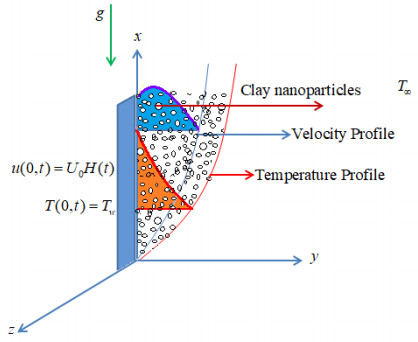









 DownLoad:
DownLoad:
